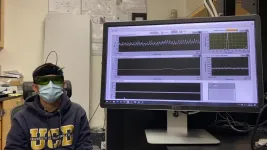INFORMATION:
A PROMPT, low-cost platform speeds up gonorrhea testing and spots antibiotic resistance
2021-05-12
(Press-News.org) A portable, rapid testing platform can detect gonorrhea infections in patient samples in under 15 minutes, far faster than standard-of-care tests that can take hours or days. The platform accurately detected infections and determined resistance to a common antibiotic in 217 patient samples from sexual health clinics in Baltimore and Uganda. The technology's speed and low cost could empower quicker and more affordable gonorrhea testing in low-resource regions, as well as help combat the spread of drug-resistant strains. Rates of gonorrhea and other sexually transmitted infections (STIs) have soared worldwide, and an estimated 1 million people now acquire an STI every day globally. Clinicians are especially concerned about gonorrhea, as Neisseria gonorrhoeae bacteria are rapidly becoming resistant to standard antibiotics. Furthermore, current tests for gonorrhea are expensive and take hours to complete, making it harder for patients to receive a timely diagnosis and appropriate antibiotics. There is therefore an urgent need for faster and cheaper testing, especially in low-income countries that lack testing capabilities and face a high burden of drug-resistant infections. Alexander Trick and colleagues present their PROMPT platform, a cartridge-based PCR testing device that both detects N. gonorrhoeae and analyzes the bacteria's resistance to the antibiotic ciprofloxacin. When applied to 66 penile swab samples from Baltimore, MD and 151 swab samples from Kampala, Uganda, PROMPT detected infections in under 15 minutes with a sensitivity and specificity of 97.7% and 97.6%, respectively. Trick et al. note their study has limitations, as more work is needed to test the platform with vaginal and urine samples and to improve the cartridge system. "Nonetheless, [these] advances ... show promise for delivering rapid, gold standard infectious disease diagnostics in a scalable and accessible format ..." the authors conclude.
ELSE PRESS RELEASES FROM THIS DATE:
Measuring brain blood flow and activity with light
2021-05-12
A new, noninvasive method for measuring brain blood flow with light has been developed by biomedical engineers and neurologists at the University of California, Davis, and used to detect brain activation. The new method, functional interferometric diffusing wave spectroscopy, or fiDWS, promises to be cheaper than existing technology and could be used for assessing brain injuries, or in neuroscience research. The work is published May 12 in Science Advances.
"Now we can assess how well the brain regulates blood flow, and even detect brain activation noninvasively in adult humans, using principles similar to functional ...
Research reveals ancient people had more diverse gut microorganisms
2021-05-12
MISSOULA - Only an anthropologist would treasure millennia-old human feces found in dry caves.
Just ask Dr. Meradeth Snow, a University of Montana researcher and co-chair of UM's Department of Anthropology. She is part of an international team, led by the Harvard Medical School-affiliated Joslin Diabetes Center, that used human "paleofeces" to discover that ancient people had far different microorganisms living in their guts than we do in modern times.
Snow said studying the gut microbes found in the ancient fecal material may offer clues to combat diseases like diabetes that afflict people living in today's industrialized societies.
"We ...
Scientists use genetic engineering to explore mechanisms involved in psychiatric disorders
2021-05-12
Researchers used genetic engineering tools to create a virus that can enter specific neurons and insert into the prefrontal cortex a new genetic code that induces the production of modified proteins. In tests with mice, the alteration of these proteins was sufficient to modify brain activity, indicating a potential biomarker for the diagnosis of psychiatric disorders such as schizophrenia and autism.
Sometimes referred to as the "executive brain", the prefrontal cortex is the region that governs higher-level cognitive functions and decision making. Studies of tissue from this brain region in patients with schizophrenia have detected alterations in two proteins: BDNF (brain-derived neurotrophic factor) and trkB (tyrosine receptor kinase B).
The relationship ...
New research may explain shortages in STEM careers
2021-05-12
A new study by the University of Georgia revealed that more college students change majors within the STEM pipeline than leave the career path of science, technology, engineering and mathematics altogether.
Funded by a National Institutes of Health grant and a National Science Foundation Postdoctoral Fellowship and done in collaboration with the University of Wisconsin, the study examined interviews, surveys and institutional data from 1,193 students at a U.S. midwestern university for more than six years to observe a single area of the STEM pipeline: biomedical fields of study.
Out of 921 students ...
UCLA scientists decode the 'language' of immune cells
2021-05-12
UCLA life scientists have identified six "words" that specific immune cells use to call up immune defense genes -- an important step toward understanding the language the body uses to marshal responses to threats.
In addition, they discovered that the incorrect use of two of these words can activate the wrong genes, resulting in the autoimmune disease known as Sjögren's syndrome. The research, conducted in mice, END ...
Study finds ghost forest 'tree farts' contribute to greenhouse gas emissions
2021-05-12
A new study from North Carolina State University finds that greenhouse gas (GHG) emissions from standing dead trees in coastal wetland forests - colloquially called "tree farts" - need to be accounted for when assessing the environmental impact of so-called "ghost forests."
In the study, researchers compared the quantity and type of GHG emissions from dead tree snags to emissions from the soil. While snags did not release as much as the soils, they did increase GHG emissions of the overall ecosystem by about 25 percent. Researchers say the findings show snags are important for understanding the total environmental impact of the spread of dead trees in coastal wetlands, known as ghost forests, ...
A delicate balance: Learning new ways that gut microbes educate the immune system
2021-05-12
The immune system's main job is identifying things that can make us sick. In the language of immunology, this means distinguishing "self" from "non-self": The cells of our organs are self, while disease-causing bacteria and viruses are non-self.
But what about the billions of bacteria that live in our guts and provide us with benefits like digesting food and making vitamins? Are they friend or foe?
This isn't only a philosophical question. An immune system that mistakes our good gut bacteria for an enemy can cause a dangerous type of inflammation in the intestines called colitis. An immune system that looks the other way while gut microbes spill past their assigned borders is equally dangerous. Understanding ...
How the body builds a healthy relationship with 'good' gut bacteria
2021-05-12
Our body's relationship with bacteria is complex. While infectious bacteria can cause illness, our gut is also teaming with "good" bacteria that aids nutrition and helps keep us healthy. But even the "good" can have bad effects if these bacteria end up in tissues and organs where they're not supposed to be.
Now, research published in END ...
'Opioid treatment deserts' abound, study finds
2021-05-12
COLUMBUS, Ohio - Neighborhoods without opioid treatment providers likely serve as a widespread barrier to care for those who are ready to seek help, a new study has found.
The study, led by researchers at The Ohio State University, appears today (May 12, 2021) in the journal PLOS ONE.
"The study identified clear opioid treatment deserts that undoubtedly stand in the way of access to needed care and that likely exist throughout the state and the nation. These are areas where treatment providers should be setting up shop - we need a surge of resources into these areas," said Ayaz Hyder, an assistant professor in Ohio State's College of Public Health ...
Elephant seals' extreme diving allows them to exploit deep ocean niche
2021-05-12
Elephant Seals' Extreme Diving Allows Them to Exploit Deep Ocean Niche
Using data captured by video cameras and smart accelerometers attached to female elephant seals, Taiki Adachi and colleagues show that the animals spend at least 80% of their day foraging for fish, feeding between 1,000 and 2,000 times per day. The unique glimpse at elephant seal foraging strategy shows how these large marine mammals exploit a unique ocean niche filled with small fish. The findings also may offer a way to monitor the health of the mesopelagic zone, the dark and cold ocean "twilight zone" ecosystem at 200 to 1,000 meters deep. Small mesopelagic fish dominate the world's ocean ...




